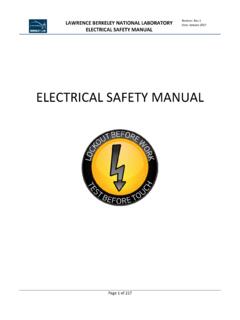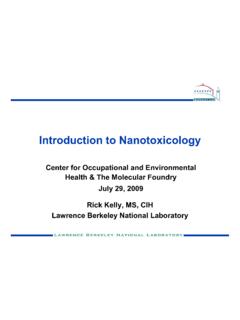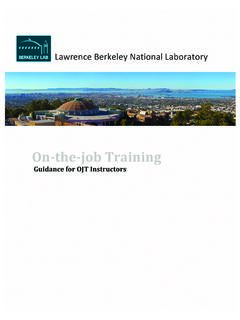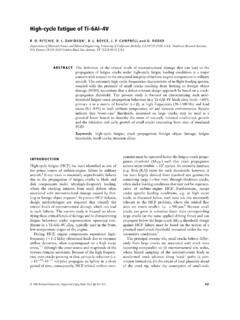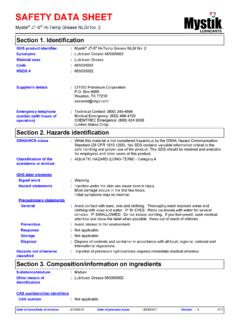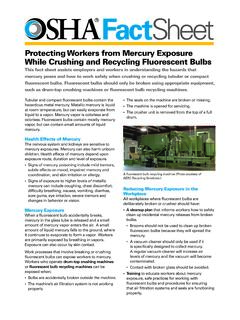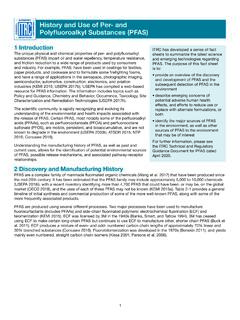Transcription of Safety Tips for Using UV Curing Systems
1 1 Safety Tips for Using UV Curing Systems What Are UV Curing Systems ? UV Curing is a speed Curing process in which high-intensity ultraviolet (UV) light is used to create a photochemical reaction that instantly cures inks, adhesives, and coatings. Curing Systems are widely used in optical, fiber-optic, electronic, laser, microelectronic, and semiconductor applications. Types of UV Curing include spot Curing , flood Curing , hand-held Curing , and conveyor Curing ; examples are pictured on the next page. UV Curing Systems use a variety of lamps as the UV light sources: mercury vapor lamps (with additives such as iron and gallium); fluorescent lamps; and l ight-emitting diodes (LEDs). The mercury vapor lamp has an output in the short-wave UV range, between 220 and 320 nanometers (nm), and a spike of energy in the long-wave range, at 365 nm.
2 This lamp is a good choice for clear coatings and thin ink layers and produces hard-surface cures and high-gloss finishes. The addition of iron to the lamp yields a strong output in the range between 350 and 400 nm, while the addition of gallium yields a strong output between 400 and 450 nm. UV LED devices are capable of emitting a narrow spectrum of radiation ( 10 nm), while mercury lamps have a broader spectral distribution. The spectral distribution of fluorescent ultraviolet lamps can be fairly narrow, although not as narrow as LEDs. Lamps Used in UV Curing Systems Mercury vapor lamp A mercury vapor lamp is a gas discharge lamp that uses an electric arc through vaporized mercury to produce light. The arc discharge is generally confined to a small fused quartz arc tube mounted within a larger borosilicate glass bulb.
3 In low-pressure mercury vapor lamps, only the lines at 184 and 253 nm are present. Only the light at 253 nm is usable. Synthetic quartz can be used in the manufacturing to keep the 184 nm light from being absorbed. In medium-pressure mercury vapor lamps, the lines from 200 to 600 nm are present. The lamps can be constructed to emit primarily in the UV-A (~400 nm) or UV-C (~250 nm) ranges. High-pressure mercury vapor lamps are commonly used for general lighting purposes. They emit primarily in blue and green light. Fluorescent lamp Fluorescent lamps are used for UV Curing in a number of applications, such as when the excessive heat of mercury vapor is undesirable, or when the Curing of the surface of an object ( , musical instruments) needs more than a single source of light and benefit from being surrounded by light.
4 Fluorescent lamps can be created that produce UV anywhere within the UV-A/UV-B spectrum. Light-emitting diode (LED) LEDs have the advantage of instantaneous turn-on/turn-off, fast and uniform drying/ Curing , low heat emission, and low power consumption. 2 Examples of UV Curing Systems Threshold Limit Values The most restrictive applicable threshold limit value (TLV) for a UV Curing system is the UV-C at 253 nm, which is set at 6 millijoules per square centimeter. This is the maximum safe level one may receive in an 8-hour period. To compare the radiant exposure TLV to the irradiance of the unit, a conservative estimate of potential exposure time must be used. If one is potentially exposed for the entire 8 hours, the effective irradiance TLV is microwatt per square centimeter.
5 LED Curing UV LED spot Curing Multi-pole LED UV Curing system Portable UV Curing system Hand-held UV Curing system for coating, drying, touch-up Benchtop UV Curing system UV Curing chambers and ovens 3 Hazard and Risks from UV Radiation Generated by UV Curing Systems UV Curing Systems produce light radiation from UV through visible light. The biggest hazard comes from the UV radiation. UV radiation cannot be seen and is not felt immediately, but it is harmful to human tissue in the eyes and skin. The user may not realize the danger until after the exposure has caused damage. Symptoms can occur 4 to 24 hours after exposure. The effects on skin are of two types: acute and chronic. Acute effects appear within a few hours of exposure, while chronic effects are long-lasting and cumulative and may not appear for years.
6 An acute effect of UV radiation is redness of the skin called erythema (similar to sunburn). Chronic effects include accelerated skin aging and skin cancer. UVR is absorbed in the outer layers of the eye the cornea and conjunctiva. Acute overexposure leads to a painful temporary inflammation, mainly of the cornea, known as photokeratitis. Repeat overexposure to the UV is unlikely because of the pain involved. Chronic exposure leads to an increased risk of certain types of ocular cataracts. Working unprotected for even a few minutes can cause injury. It is possible to calculate threshold for acute effects and to set exposure limits. It is not possible, however, to calculate threshold for chronic effects; therefore, because no exposure level is safe, exposure should be reduced as much as possible.
7 Other Hazards Related to Use of UV Curing Systems Lamp explosion Mercury vapor lamps used in UV Curing Systems contain high-pressure gas and may explode if not handled properly. Wear cotton gloves when handling the lamp. Avoid touching or scratching the glass section of the lamp. Fingerprints should be wiped off with isopropyl alcohol and a clean soft tissue; otherwise they will weaken the lamp envelope. Install the lamp with the proper polarity of electrical wiring. Do not stress the glass parts when tightening electrical connections. Replace the lamp when it reaches its lifetime limit. An old lamp having a darkened glass envelope has a high likelihood of exploding and should be replaced. Mercury (Hg) Mercury contamination can occur if a lamp breaks or explodes. Consult with the industrial hygienist on proper handling of mercury contamination.
8 Ventilate the room for at least 30 minutes. Ozone Short-wavelength UV light converts oxygen into ozone. Ozone produced by lamps with high UV output can be a major irritant to the user. Even ozone-free lamps can produce enough ozone to be uncomfortable for someone who is particularly ozone sensitive. Proper ventilation should be considered before the system is in use. Cotton Gloves 4 Heat The mercury lamp envelope reaches very high temperatures during normal operation and can cause severe burns if touched. Let the lamp cool at least 15 minutes before opening the lamp compartment door. Also, surfaces exposed to high-intensity Curing lights will rise in temperature. In some cases, exposed surfaces can reach temperatures capable of producing a burn or causing damage. Care should be taken to ensure that surfaces do not exceed a moderate temperature and that operators have appropriate protection and training.
9 Bright visible light The bright visible light emitted by some UV Curing Systems can result in eyestrain for some workers. Tinted protective goggles and/or a face shield should be used. Electrical shock During normal operation, the user is protected from contact with any energized electrical connections. However, electrical shock danger will occur if interlocks are defeated or the power supply section is opened with the unit still plugged in. Unplug the unit before replacing the lamp or servicing the power supply section. Limiting UV Exposure Control measures must be in place to limit exposure to eyes and skin and to prevent cumulative exposure. The precautions needed depend on the risk assessment. Control measures designed to eliminate the risk of exposure to UV at its source, such as engineering and administrative controls and personal protective equipment (PPE), must be implemented wherever possible.
10 A key element in achieving the goal of reduced UVR exposure is worker training and awareness. Engineering Controls Location Having equipment located in a separate room, alcove, or low-traffic area of a lab is ideal. To avoid exposure to other personnel, avoid placing equipment in the vicinity of desk areas or other equipment. Enclosure/Shield The use of enclosures is the preferred means of preventing UV exposure. Where it is not practicable to fully enclose the UV source, use screens, shields, and barriers, such as the following: metal sheet ( , aluminum or steel that has been coated black or is black anodized) that is used to minimize the operator s exposure to reflected UV and visible light. Rigid plastic film (transparent, UV-blocking plastics, typically polycarbonate or acrylic) that is commonly used to create shielding yet maintain transparency.




